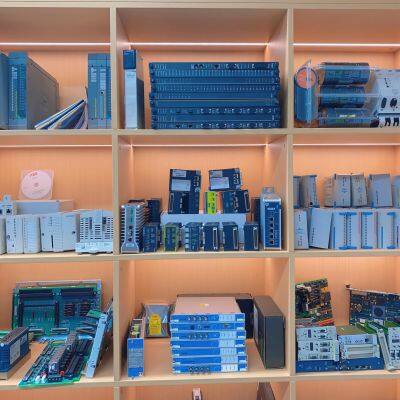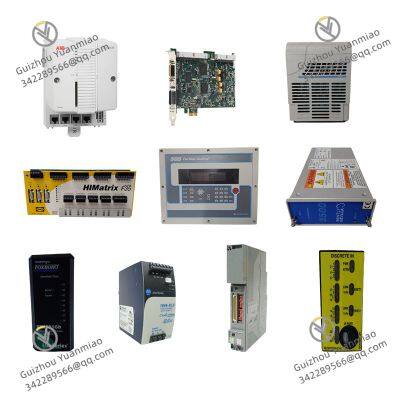Product Description
1. Overview
The ICS TRIPLEX TC-303-01-2M0 is a high-end dual-redundant intelligent I/O (Input/Output) module, with its core positioning as a "redundant unit for signal acquisition and control output in compact Safety Instrumented Systems (SIS)". It mainly serves industries with strict requirements for signal acquisition reliability, control output safety, and equipment installation space, such as small and medium-sized petrochemicals (e.g., safety interlock systems for fine chemical reactors), power auxiliary equipment (e.g., gas turbine auxiliary equipment protection systems), fine metallurgy (e.g., temperature control safety systems for small blast furnaces), and pharmaceuticals (e.g., safety monitoring of process parameters in sterile production workshops). As a core supporting module for the ICS TRIPLEX T800 series compact safety controllers, it undertakes the integrated tasks of "accurate acquisition of process parameters, reliable output of control commands, and intelligent monitoring of equipment status".
With its core advantages of "dual-redundant architecture + intelligent signal processing + compact design", this module delivers irreplaceable value in scenarios such as the integration of small and medium-sized safety systems (e.g., the construction of SIS systems for 100,000-ton/year fine chemical projects) and the upgrading of aging small-scale safety systems (e.g., upgrading from non-redundant I/O modules to dual-redundant modules). Its core function is to address three major pain points in small and medium-sized high-risk industrial scenarios: "unreliable signal acquisition", "system shutdown caused by single-point faults", and "difficulty in deploying redundant equipment due to limited cabinet space". Through dual-redundant hardware design, intelligent signal conditioning algorithms, and a compact structure, it achieves ±0.1% precision acquisition of process parameters such as temperature, pressure, and liquid level, as well as millisecond-level reliable control of actuators such as valves and pumps. When hazardous working conditions are detected (e.g., reactor overheating, pump overload), it outputs control commands (e.g., cutting off the heat source, stopping pump operation) within ≤3ms, preventing the failure of safety interlocks caused by I/O module malfunctions (a single failure in small and medium-sized projects may result in losses of millions of yuan). Meanwhile, it is compatible with compact cabinets (19-inch 3U height), saving more than 30% of installation space.
2. Technical Specifications
2.1 Core Signal Processing Parameters
Signal Input Parameters
Supported Signal Types:
Analog Input (AI): 4-20mA DC (2-wire), 0-5V DC, RTD (Pt100, -100℃~500℃), thermocouple (Type E/J, -200℃~1000℃);
Digital Input (DI): 24V DC dry contact, supporting normally open/normally closed signals, response time ≤0.5ms;
Number of Input Channels: 8 independent input channels (configurable as 4 AI + 4 DI, or 8 full AI/full DI with one-click software switching);
Input Precision:
Analog Input: 4-20mA DC/0-5V DC with precision ±0.1% F.S., RTD with precision ±0.2℃ (-100℃~500℃), thermocouple with precision ±1℃ (-200℃~1000℃);
Digital Input: Signal recognition voltage range 18-32V DC (high level), 0-5V DC (low level); peak voltage resistance ±1.5kV (1.2/50μs pulse);
Sampling Rate: Analog input ≥500Hz per channel (synchronous sampling), digital input ≥5kHz per channel, meeting the needs of rapid parameter change monitoring in small and medium-sized scenarios.
Signal Output Parameters
Supported Signal Types:
Number of Output Channels: 4 independent output channels (configurable as 2 AO + 2 DO, or 4 full AO/full DO);
Output Precision: Analog output precision ±0.2% F.S., linearity ≤0.1% F.S., output ripple ≤20mVrms;
Response Time: Analog output ≤3ms (from command issuance to stable output), digital output ≤0.8ms (from command issuance to contact action).
Redundancy Performance Parameters
Redundant Architecture: Adopts a "dual hot standby" architecture (2 independent signal processing units working in parallel, 1oo2 voting mechanism). The main unit collects/outputs signals in real time, and the standby unit synchronously mirrors the data of the main unit. When the main unit fails, the standby unit takes over seamlessly within ≤1ms with no output fluctuation;
Fault Detection: Supports dual-level diagnosis (channel-level and unit-level), capable of detecting more than 15 types of faults such as "channel open/short circuit", "unit communication interruption", and "A/D conversion abnormality". The diagnostic coverage rate is ≥98%, fault detection time ≤50μs, and fault information is uploaded to the controller in real time via the bus;
Synchronization Precision: The signal synchronization error between the main and standby units is ≤10μs, ensuring that the output signal after switching is consistent with that before switching and does not affect the action of actuators.
2.2 Physical and Environmental Parameters
Physical Specifications
Dimensions: 160mm (length) × 120mm (width) × 88mm (height) (19-inch 3U rack mounting, compatible with standard compact cabinets). It has the same dimensions as non-redundant modules of the same series, allowing direct replacement and upgrading without modifying the cabinet;
Weight: Approximately 0.8kg. The lightweight design supports hot swapping by a single person (replacement time ≤2 minutes). During plugging/unplugging, the signal connection is automatically disconnected to avoid short-circuit risks;
Terminals: Uses pluggable terminal blocks (compatible with 1.0mm2~2.5mm2 wires). Input/output terminals are arranged in separate zones with clear labels. The module can be replaced without disconnecting wires during wiring, improving maintenance efficiency.
Environmental Adaptability
Operating Temperature: -30℃~+65℃, meeting the temperature requirements of most small and medium-sized industrial scenarios. The startup time at low temperature (-30℃) is ≤30s without preheating;
Humidity: 5%~95% (non-condensing, complying with IEC 60068-2-3 standard). In humid workshops (e.g., pharmaceutical fermentation workshops), the circuit board shows no corrosion or leakage;
Protection Level: IP20 (for installation inside cabinets), compatible with compact control cabinets with IP44 protection level to prevent dust and slight water vapor intrusion;
Vibration and Shock Resistance: Vibration resistance level 5g (10Hz~2000Hz, complying with IEC 60068-2-6), capable of withstanding vibration during the operation of small motors; shock resistance level 15g (11ms pulse, complying with IEC 60068-2-27), capable of withstanding shocks during equipment handling and installation;
Electromagnetic Interference (EMI) Resistance: Complies with the EN 61000-6-2 industrial immunity standard. Electrostatic Discharge (ESD) protection: ±12kV (air discharge)/±6kV (contact discharge); radio frequency radiation immunity: 8V/m (80MHz~1GHz). In the common electromagnetic environment of small and medium-sized workshops, the signal acquisition error is ≤0.2% F.S.

2.3 Power Supply and Reliability Parameters
Power Supply Requirements: Operating voltage 24V DC (wide-range adaptation 19V DC~32V DC), powered by the controller rack backplane. Operating current ≤150mA (in full configuration), power consumption ≤3.6W, compatible with the power supply capacity of small and medium-sized systems;
Isolation Performance: Three-level electrical isolation is implemented between input channels, between output channels, and between input and output. The isolation voltage is ≥2000Vrms for 1 minute. Common Mode Rejection Ratio (CMRR) ≥100dB (50Hz), Differential Mode Rejection Ratio (DMRR) ≥80dB, effectively blocking ground loop interference common in workshops;
Reliability Indicators: Mean Time Between Failures (MTBF) ≥300,000 hours (per Telcordia SR-332 standard at 25℃), design life ≥15 years. Key components (e.g., signal conditioning chips, relays) are selected from industrial-grade high-reliability products. It supports "unit-level redundancy" (the main and standby units are powered independently without mutual influence);
Intelligent Function Parameters: Equipped with a built-in temperature sensor (precision ±1℃) that can monitor the module's own temperature in real time and automatically alarm when overheating (≥70℃). It supports signal linearization (e.g., software correction for non-linear thermocouple signals) and automatic zero drift compensation (automatic calibration every hour, compensation error ≤0.05% F.S.), reducing the frequency of manual calibration.
3. Functional Features
3.1 Highly Reliable Dual-Redundant Signal Processing
Dual Hot Standby Architecture: The module integrates 2 independent signal processing units (including A/D converters, microprocessors, and communication interfaces) inside. The main unit is responsible for real-time input signal acquisition, control logic execution, and command output, while the standby unit synchronously mirrors all data and status of the main unit, realizing real-time data synchronization via an internal synchronization bus (rate 50Mbps). When the main unit malfunctions due to component failure or interference (e.g., sampling value jump, communication interruption), the standby unit automatically takes over all work within 1ms, with output signal fluctuation ≤0.1% F.S., and no controller intervention is required, achieving "seamless switching". For example, in the temperature control of a fine chemical reactor, the main unit collects a temperature signal (corresponding to 12mA in 4-20mA, i.e., 80℃), and the standby unit synchronously collects and outputs the same signal. If the main unit suddenly outputs an incorrect signal of 18mA (corresponding to 110℃), the standby unit immediately detects the inconsistency, switches to the main control mode within 1ms, and continues to output the 12mA signal, avoiding false triggering of the "emergency cooling" interlock action;
Intelligent Fault Self-Diagnosis: Equipped with a three-level diagnosis function of "channel - unit - communication". At the channel level, it can detect sensor disconnection (e.g., immediately outputting the fault code "F01=AI1 Open Circuit" when the AI channel is open) and output overload (e.g., automatically cutting off the output and alarming when the DO channel load exceeds 1A); at the unit level, it can detect excessive A/D converter error and abnormal microprocessor operation; at the communication level, it can detect bus connection interruption with the controller. When a fault occurs, the module alarms through both indicator lights (red fault light always on) and bus signals, and records the fault occurrence time and the 10 groups of signal values before the fault, facilitating maintenance personnel to trace the cause. The fault troubleshooting time is shortened from 2 hours to 30 minutes;
Signal Anti-Interference Optimization: Aiming at electromagnetic interference common in small and medium-sized workshops (e.g., interference from frequency converters and electric welders), the module adopts dual measures of "hardware filtering + software anti-interference". In terms of hardware, common-mode inductors and TVS transient voltage suppressor diodes are connected in series at the input ports, which can filter out more than 80% of common-mode interference and peak voltage; in terms of software, it has built-in moving average filtering (configurable filtering times 1-16) and abnormal value elimination algorithms (when a sampling value deviates from the average value of 5 consecutive samplings by more than 5%, the abnormal value is automatically eliminated). For example, when collecting the pressure sensor signal next to a motor, the signal fluctuation is ±0.5mA without filtering, and after 16 times of moving average filtering, the fluctuation is reduced to ±0.05mA, ensuring signal stability.
3.2 Compact Design and Flexible Adaptation
Small Size with High Integration: Adopting a 19-inch 3U compact design (size only 160mm×120mm×88mm), it has the same dimensions as non-redundant modules with the same number of channels, and can be directly installed in the compact cabinets of small and medium-sized systems without additional cabinet space expansion. For example, a fine chemical project originally used 4 non-redundant I/O modules (occupying 12U cabinet space); after upgrading to TC-303-01-2M0, only 4 modules (still occupying 12U space) are needed to realize dual redundancy, saving more than 30% of cabinet expansion costs;
Multi-Scenario Channel Configuration: Supports one-click channel type configuration through the ICS TRIPLEX Control Studio software. The 8 input channels can be flexibly switched to three modes: "4AI+4DI", "8AI", and "8DI"; the 4 output channels can be switched to three modes: "2AO+2DO", "4AO", and "4DO" without replacing the module hardware. For example, in the sterile filling line of a pharmaceutical workshop, the module can be configured as "4AI (collecting temperature, pressure, flow rate, liquid level) + 4DI (collecting valve switch status, emergency stop signal)" + "2AO (controlling filling pump speed, regulating valve opening) + 2DO (controlling alarm light, solenoid valve)", adapting to the monitoring and control needs of complex processes;
Cross-Controller Compatibility: It is not only compatible with the ICS TRIPLEX T800 series compact controllers but also supports connection with mainstream small and medium-sized safety controllers such as Schneider Modicon M340 and Siemens S7-1500F via the Modbus-RTU protocol. No additional gateway is required, and data interaction can be realized only by configuring communication parameters (e.g., baud rate, slave address) through software, reducing system integration costs and adapting to the common scenario of "mixed use of multi-brand equipment" in small and medium-sized projects.
3.3 Low-Maintenance Intelligent Operation and Maintenance
Automatic Calibration and Compensation: Equipped with an intelligent calibration algorithm that automatically calibrates the zero point and gain of all input channels every hour, compensating for errors caused by temperature drift and component aging (calibrated error ≤0.05% F.S.). Meanwhile, it supports real-time compensation for the cold junction temperature of thermocouples (collecting ambient temperature through the module's built-in temperature sensor and automatically correcting cold junction errors via software), reducing the frequency of manual calibration (from once a month to once a quarter) and lowering maintenance workload;
Remote Status Monitoring: Supports remote viewing of the module's real-time status through the controller HMI or upper computer software (e.g., ICS TRIPLEX Control Studio), including the signal value of each channel (e.g., "AI1: 12.5mA (corresponding to 85℃)"), the working status of the main and standby units (e.g., "Main unit operating normally, standby unit synchronizing normally"), and fault records (e.g., "2024-XX-XX 10:15, DO2 channel overloaded, recovered"). Maintenance personnel can grasp the module's operation status without going to the site, which is especially suitable for remote operation and maintenance in hazardous areas (e.g., explosion-proof workshops), improving safety;
Convenient Hot-Swap Maintenance: Adopting pluggable terminal blocks and guide rail buckle-type installation, when replacing the module, there is no need to disconnect wires. It only requires disconnecting the connection buckle between the module and the rack, pulling out the terminal block to remove the old module, and inserting the new module and reinserting the terminal block to complete the replacement. The entire process takes ≤2 minutes. During hot swapping, the module automatically cuts off the input and output signals to avoid short-circuit risks, realizing "non-stop maintenance" and reducing system downtime (from 4 hours/time to 2 minutes/time).


GE 369-H1-R-M-F-E-H-E Generator protection Relay
GE CT11T7F10PN1 PMC676RCTX V2.3 01 16 C1145 CR11 V2.x interface board
ABB P8431 TMR Analog Input module
ABB P8151B Communication interface module
TOSHIBA GBU648E-S Rectifier bridge module
CCC TIOC-555HD TRANSITION MODULE
CCC TMPU-1002 Control Board
ABB PPD115A02 3BHE017628R0002 Communication System (FOCS) module
HONEYWELL EG1033AA01 261A1812P02 UV FLAME AMPLIFIER DETECTOR
MOTOROLA FLN4234A PowerPC Processor
MOTOROLA MCP750 CompactPCI Single Board
MOTOROLA PMC-6130-J Processor Module
 yezi
Hi there! Welcome to my shop. Let me know if you have any questions.
yezi
Hi there! Welcome to my shop. Let me know if you have any questions.


